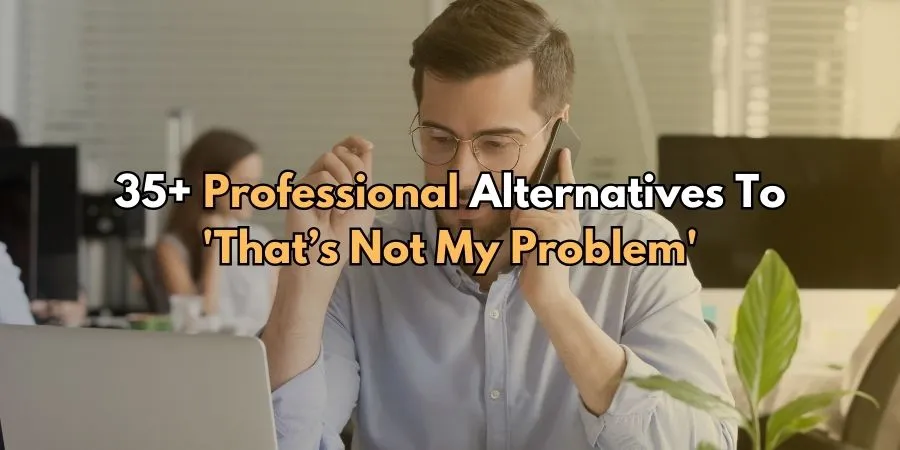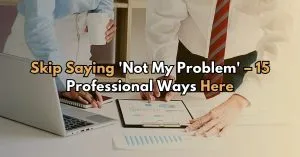Handling an issue that falls outside your jurisdiction or responsibility in a professional setting requires tact and diplomacy.
When you find yourself in such scenarios, it’s crucial to communicate your boundaries and limitations without appearing dismissive or uncooperative.
Instead of saying “That’s not my problem,” a more respectful and professional response would be the best approach.
Below are some professional ways to say “That’s not my problem” you can utilize to sound more qualified and ethical worker.
Contents
Polite & Personalized Alternatives
1. I appreciate you bringing this to my attention, though it’s not part of my role.
2. My involvement in these matters is limited—perhaps someone else could provide better assistance?
3. I don’t know to weigh in on that.
4. I think that falls under someone else’s jurisdiction.
5. It’s good you learned about this early, but I’m not the person you need.
6. Sorry, that falls outside my responsibilities.
7. Could you check with someone on the higher-ups? They can guide you better.
When Talking To Someone In The Workplace
1. I see why this is a concern. Have you considered discussing this with [specific department or person]?
2. Your issue sounds significant, but it’s beyond my role. How about I direct you to the right resource?
3. That definitely needs attention. [Name] is actually the expert on this—how about reaching out to them?
4. I’m not the best person for this issue, but I know [name] has handled similar situations before. Want me to introduce you?
5. Your best bet is to check with [name] since they manage these matters.
SUGGESTED: Not Just ‘Yes’ or ‘No’ – 15 Dynamic ‘Are You Busy?’ Answers
When Talking To Customers
1. Thank you for bringing this to our attention. The best folks to help with this are over in [specific department]. I’ll point you their way!
2. It sounds like you need an expert in [area of concern]. Let me quickly transfer you to someone who can help right away.
3. To ensure you get the best help possible, I’m going to put you through to our [specific department]. They’re great at handling such issues.
Why Avoid Saying “That’s Not My Problem” Directly?
Saying “That’s not my problem” can create a cold, unfriendly environment, where teammates may feel sad or angry, leading to a negative atmosphere that can affect everyone’s ability to collaborate and grow.
Instead, showing a willingness to help and share ideas not only benefits the team but also enhances your professional image as a team player.

It’s about being supportive, not just doing your job; it puzzles out bigger victories through teamwork, ensuring that everyone, including your boss, sees you as an indispensable worker committed to collective success.
SUGGESTED: Don’t Miss Out! 21 Expert Ways To Say “This Is Your Job”
Why Is It Important To Communicate Professionally In Challenging/Heated Situations?
In high-stress or tense situations, how we talk can either escalate or diffuse potential conflicts. Choosing to communicate kindly and calmly—even when you’re feeling upset or angry—helps control emotions and fosters a more cooperative environment.
Maintaining clarity in your instructions and talking calmly under pressure are critical because they prevent misunderstandings from becoming big problems. When everyone involved understands and trusts that they are being heard, it’s easier to rely on each other to fix issues efficiently.
How to Maintain Professionalism in Heated Exchanges?
During heated exchanges, it’s essential to keep your voice soft and gentle to maintain a calm and cool situation. Speaking softly helps prevent escalation and demonstrates control over your emotions, which is crucial in professional settings.
By being empathetic to the other person’s point of view, you foster an environment where both parties feel understood, even when upset.
Always speak in inclusive terms using words like “we” instead of “you” to emphasize collaboration and shared goals. This shift in language encourages a collective effort to solve the problem.
Related Posts You May Like:


